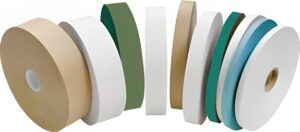Banding with paper and film is becoming one of the preferred choices for the pharmaceutical industry to bundle and unitize their products while seeking to improve productivity and reduce costs. Banding offers many perks: The equipment is compact with a small footprint and can be moved around easily; it can also be incorporated in production lines with infeed and exit conveyors to speed commercial-scale output.
Banding machines are functionally straightforward: They wrap a strip of paper or film around a given product or groups or bundles of products. When stacks of blister packs or sachets are ready to be bundled, they are placed in the bander, where a sensor detects the bundle and actuates the machine which automatically dispenses a band that wraps around the bundled of goods and binds them together. More sophisticated equipment can gather, count, stack and band; others will take a continuous feed of boxed products and create bundles in various configurations.
Historically, shrink wrapping represented the typical unitizing or bundling mode for packaging in the pharmaceutical industry. However, because of the concern for potential damage caused from shrink-wrap tunnels, banding is growing in popularity. For one, it supports the same bundling operation without heat potentially affecting the product. Two, cost control is an advantage because banding solutions are less expensive to operate or maintain than shrink-wrap film or chipboard sleeve solutions.
ACCESS SIMPLIFIED
Paper bands are easily removed and, provided the banding machine is set up and configured correctly, will not deform or damage the shape of the product. Bands can also support or enhance brand identity and integrity; clear film bands can enhance the appearance of the finished bundle, for example, and both paper and film can be printed on and provide real estate to display secondary messaging to support a range of information agendas and eliminate separate, expensive, pressure-sensitive labels. Whether the final product is a stack of blister packs, small cartons, trays or clamshells, paper and film bands offer a practical, cost-effective solution.
As mentioned, banding materials can offer great opportunity for savings, but operations and purchasing managers might not be aware of how best to attain them within their own operations. After purchasing the equipment and the necessary film and paper banding, many customers may find themselves single-sourced. Pursuing quotes from a conventional packaging supplier may limit one’s access to high-performing, cost-effective materials and prove a fruitless exercise because of their limited knowledge of the technology or narrow material inventory. An original supplier, once established, can hold a virtual monopoly on pricing channeling only those materials that serve their bottom line best.
Additionally, traditional packaging distributors offering conventional packaging material (stretch film, bubble, foam, corrugated, and Jan/San products, etc.) may not have the converting capabilities to provide alternate film or paper, so they don’t offer them. Only a rare combination of distributor/converter can enter this market.
The pricing for materials manufactured overseas isn’t necessarily stable — rather, it’s whatever the market can bear. Most high-profile large users buying pallet quantities are paying much higher prices compared to what they would pay for a domestic equivalent.
Different domestic suppliers can offer various programs. Three key considerations to look for are:
- U.S.-made and U.S.-supplied consumables. A U.S.-made product ensures readily available stock that’s not subject to overseas transportation costs or other possible delays.
- Stable pricing can be achieved with contracted blanket orders and dated deliveries for up to one year. This eliminates the ridiculously high prices of foreign material and ensures meeting budgetary forecasts. Since consumables must be continually ordered, the savings go directly to the bottom line.
- Next-day shipping to ensure customers never run out of materials, or forced to shut down production.
Domestic suppliers may offer other advantageous programs as well. Pacific Packaging Products, for example, offers a consignment program that allows customers to only pay for the material they use on a monthly basis and allows inventory/payment to be managed electronically. A consignment-based supply strategy lets customers maintain a 60-90 day supply in their warehouses. Should demand grow, materials are readily available. Furthermore, there are considerable transportation savings shipping 60-90 day supplies as compared to monthly shipments.
These products work, and there’s very little risk on the purchasing manager’s part to test domestic products. Companies are likely to enjoy tremendous additional savings on paper and film consumables, and samples are readily available to prove concepts and efficacy. Considering all of the aforementioned advantages, seeking a qualified domestic supplier is well worth the investigation.
Magdi Bichay is general manager of specialty sales and marketing at Pacific Packaging Products Inc., a film and paper manufacturer, distributor and converter based in Wilmington, MA. For further information or to request samples, contact him at 978-808-8827 or mbichay@pacificpkg.com.







